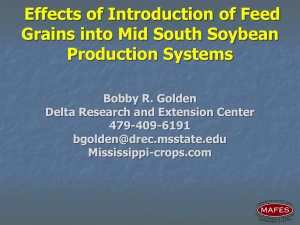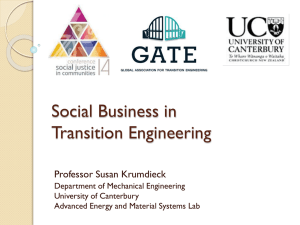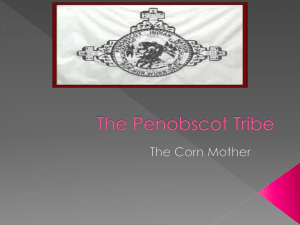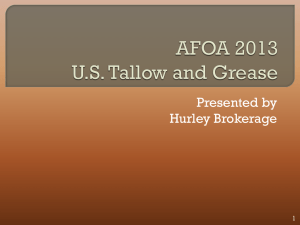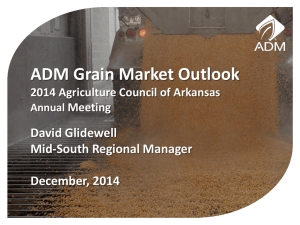Basic Insect Management : Field Crops Doug Johnson
advertisement
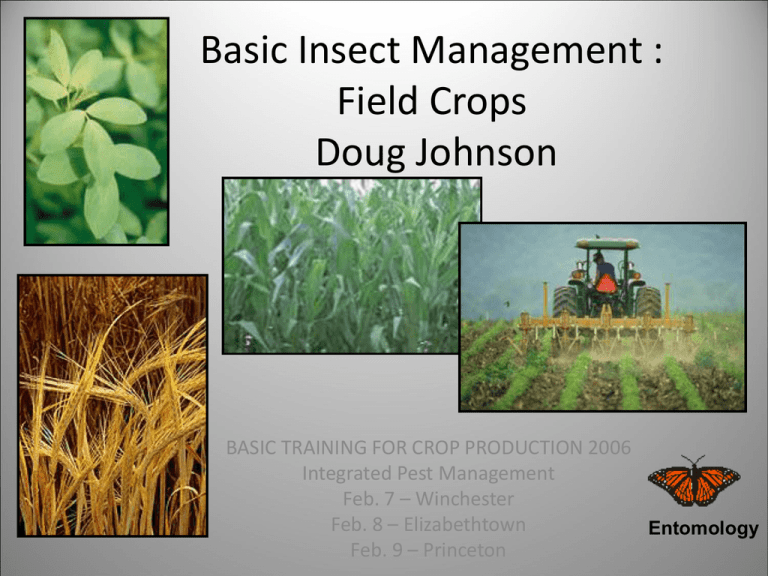
Basic Insect Management : Field Crops Doug Johnson BASIC TRAINING FOR CROP PRODUCTION 2006 Integrated Pest Management Feb. 7 – Winchester Feb. 8 – Elizabethtown Entomology Feb. 9 – Princeton Before you do anything else • Make sure the pest is correctly identified!! Many Ways to Organize • Note the “PAMS” approach • Adopted by USDA as ‘the” approach • Likely to play a large role in goal setting, evaluation (and regulation?) The PAMS Approach IPM • Prevention, • Avoidance, • Monitoring, • Suppression Prevention • Keep the pest out of the field! – Legislative; control movement of plant material and soil – Cultural; use pest free seed / transplants – Management; prevent weeds from producing seed – Mechanical; mow European corn borer staging sites in spring. Prevention KY Examples • Pest free transplants (Tobacco) – KY Production – Import restrictions e.g. plants from south? • Reduce soil movement (soil insects) • Pest free seed • Clean equipment (especially in stored grains) Avoidance • Crop Rotation • Nutrient Management • Planting Date • Timely Harvest • Uniform Planting • Avoidance of Loss of Value • Maturity groups Immigrant Insect Pests • Alfalfa – Potato leaf hopper • Corn + Grain Sorghum – Black cutworm, Fall armyworm • Soybean – Soybean aphid • Wheat – Grain aphids Potato leafhopper Adults MIGRATE north in spring - lay eggs in alfalfa. Winter management techniques or severity not effective. Avoidance • Crop Rotation – Corn - corn rootworm Avoidance • Planting Date – Alfalfa –potato leaf hopper, fall seeding – Corn - corn borers, fall armyworm – Soybean - Soybean aphid, soybean podworm – Wheat - Hessian Fly, – Grain Sorghum - Sorghum midge Avoidance • Uniform Planting – Grain Sorghum – Sorghum midge – Tobacco – aphids and corn earworm (especially in seed production) Avoidance • Maturity groups – Corn – Fall armyworm – Wheat – Cereal leaf beetle – Soybeans – Soybean podworm – Grain Sorghum – Sorghum midge Avoidance • Nutrient Management – Soybean aphid and K deficiency – Aphids and over use of N2 Avoidance • Timely Harvest – Alfalfa – potato leafhopper, cut every 30 days • Alfalfa weevil harvest to avoid spraying. Avoidance • Harvest to Avoid Loss of Value – Corn – corn borers - harvest before lodging. – Soybean – soybean stem borer, harvest before lodging. – Alfalfa – blister beetles, sell first 2 cuttings as blister beetle free. Monitoring • Crop Scouting • Damage Assessment • Trapping • Modeling Prediction (PAMS Monitoring [part]) • Estimating occurrence of new pest. – Example soybean aphid • Estimating occurrence of occasional pests – Example southwestern corn borer • Estimating occurrence of annual pests – Example arrival of black cutworm or appearance of armyworm Detection (PAMS Monitoring) Scouting (DIRECT) – Direct plant examination for pest or damage – Soil sampling wireworms, white grubs etc. • Trapping (INDIRECT) – insect pheromone traps (many moths) – Sticky / color traps (aphids) • Damage Assessment (AFTER THE DAMAGE) What will you probably see first? Stems broken just a few inches above ground You can not see a tunnel on either side of the break Notice the “beveled” edge of the stem Overwinter SWCB Survival Caldwell, Henderson, Davies, Hardin Counties Four fields/county Year SWCB Survival SWCB/stalk 1999 2000 2001 2002 2003 2004 2005 10.1 26.9 9.7 5.3 4.3 2.5 5.3 3.64 5.57 3.92 0.63 1.13 0.39 0.30 Prediction (PAMS Monitoring [part]) • Using: – predictive models, • http://wwwagwx.ca.uky.edu/Gisproducts.html – weather / climate patterns, – traps example spore traps or insect traps, – sentinel or trap crops, Monitoring leads to Decision Making • Research based tools • Experience based estimations Economic Thresholds vs Economic Injury level Number Of Pests -OrDamage Level EIL ET Time or Plant Stage etc. How do we decide? • Economic Injury Level (EIL) – The point at which the cost of injury becomes greater than the cost of control. • Economic Threshold aka Action Threshold (ET) – The level at which action should be taken. Economic Thresholds by Plant Stage ET Defoliation Maturity Vegetative Seedling Reproductive Plant Stages For example soybean aphid on soybean • Action Threshold is: – 250 aphids per plant, – Plants in V through R5 stages, – Provides one week to make application. To use the threshold you must have data from the field • Plant growth stage • Number of insects present. Suppression • Biological • Host Plant Resistance • Mechanical • Chemical Remediation (PAMS Suppression) • • • • Biological (natural enemies) Cultural (planting date, host plant resistance) Mechanical (cultivation) Chemical (pesticides) Natural Control Biological Control • Conservation – If you don’t spray when you don’t need to then you practice this! e.g. preservation of lady beetles, syrphid flies, parasitoids. • Augmentation • Importation (Classical) – Asian lady beetle Host Plant Resistance • Modern hybrid field Corn – DIMBOA (European corn borer) – Gray leaf spot resistance • Soybean – Soybean cyst nematode resistance • Wheat – Hessian Fly resistance Mechanical • Stalk / Stem destruction – Crown displacement - Soybean stem borer – Mowing staging sites - European corn borer Chemical Active ingredients • Synthetic Compounds – Many families • Formulated Pathogens – Bacillus thuringensis, e.g. Dipel – Spinosad, e.g. Naturalyte, Tracer • Botanicals – Nicotine sulfate • Soaps and Oils Chemical Deployment • Soil applied • Foliar applied • Seed coatings • Transgenic So, Where Do They Fit? • Where are they needed? • Were will they work? • Where are they economical? Yield Benefit by Planting Date 7-Year Average Planting Date Non-Bt Tunneling (in) Early – Mid April 3.2 Yield, nonBt (bu) 189.7 Yield, Diff. (bu) 3.2 Late April 4.0 198.8 2.7 Early –Mid May 4.1 182.3 6.2 Late May 5.2 160.2 9.2 Early – Mid June 6.3 112.3 21.1 Insects Controlled by Bt Corn ECB SWCB BCW FAW CRW YieldGard CB ++ ++ - + - YieldGard RW - - - - ++ YieldGard Plus ++ ++ - + ++ Herculex 1 ++ ++ ++ ++ - Herculex RW - - - - ++ Herculex Xtra ++ ++ ++ ++ ++ Traditional Corn Seed Treatments ‘Hopperbox’ Agrox Premiere Germate Plus Grain Guard Plus Kernel Guard Kernel Guard Supreme KickStart Lorsban SL True Seed Treatments Seed Treatments (Ordered with seed) – Imidacloprid Gaucho extra Prescribe (0.6 mg/kernel) (1.34 mg/kernel) – Thiamethoxam Cruiser Extreme Pak (0.25 mg/ker) Cruiser Extreme Pak CRW (1.25 mg/kernel) – Clothianidin Poncho 250 Poncho 1250 (0.25 mg/kernel) (1.25 mg/kernel) Insects Controlled WW WG FB SCM BCW CRW Gaucho ++ ++ + ++ - - Prescribe ++ ++ ++ ++ - + Cruiser Ex Pak ++ ++ ++ ++ + - Cruiser EP CRW ++ ++ ++ ++ + ++ Poncho 250 ++ ++ ++ ++ + - Poncho 1250 ++ ++ ++ ++ ++ ++ Immediate Plant Back 30-Day Plant Back 120-Day Plant Back 12 Month Plant Back Making the Control Decision • Rotation information – Corn after corn ? After pasture ? • Planting Date – Very early - wireworms – Very late – corn borers • Likelihood of Problems – Past problems ? • Cost – Is rotation more cost effective? • Equipment Soybean Seed Treatment Test Results over three years • In NO trial did any treatment ever yielded differently from the untreated check. • In all cases insect populations were minimal. • In no year was movement of plant virus important. How many ways can you make a mistake? • Treat when you don’t need to treat, – Lost cost of application & increased risk of environmental, regulatory burden • Treat when you do need to treat, – Reduced your losses but at a cost, • Don’t treat when you do need to treat, – Loss of potential yield / quality, thus income • Don’t treat when you don’t need to treat. – Conservation BioControl Secondary Outbreak 16 Application 14 12 10 Primary Pest Seconday Pest 8 6 4 2 0 1 2 3 4 5 6 7 8 9 Time or Plant Stage Etc. 0 Resurgence 14 Pesticide Application 12 10 8 Pest Counts 6 4 2 0 1 2 3 4 5 6 7 8 9 0 Time or Plant Stage Etc. Why does this happen? Insecticide applied Pest population declines, but can rebound Natural enemies crash and can not rebound RESISTANCE • Resistance has been documented in every class of insecticides involving more than 500 insect and mite species 56% are crop pests 39 % are med/vet pests 5 % are beneficial species Resistance is most common in ... • multivoltine pests – several generations per year • pests exposed to multiple sprays each season or extended-release applications RESISTANCE Tactics that will not work! • Spray more often (or constant availability) • Use a higher concentration of the pesticide These tactics may give some short term relief, but will cause the problem to get worse!! RESISTANCE Not limited to pesticides • Western corn rootworm in corn – Central IL, IN & OH – For years rotation mainstay of management – WCR now laying eggs in soybean! Two General Impacts • Short Term – will the treatment impact on the yield pay for the cost of treatment? • Long Term – Will use of the treatment result in its loss, reduce its availability, increase its cost, or increase its regulation? Management Summary • • • • • • • Identify the problem Understand the problem Measure the problem Make a decision (or plan) Apply control tactic Evaluate tactic Modify or repeat as necessary
